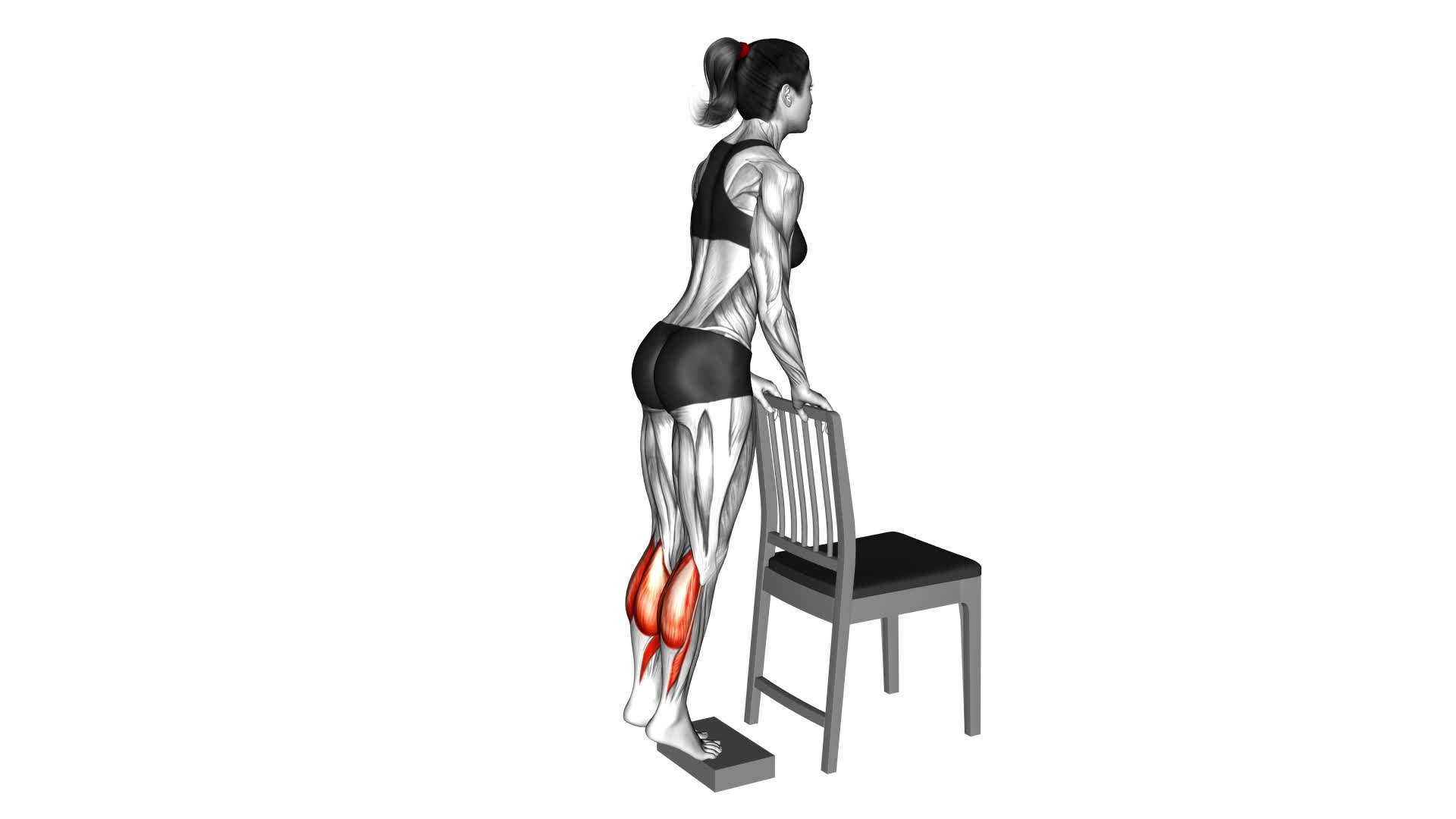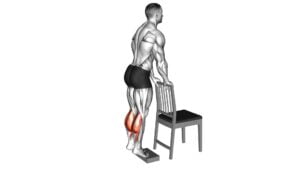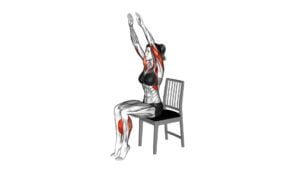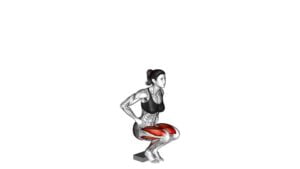Calf Raise From Deficit With Chair Supported (Female) – Video Exercise Guide & Tips

Looking to strengthen and tone your calf muscles? Look no further than the Calf Raise From Deficit With Chair Supported.
Watch This Exercise Video
This exercise is perfect for females wanting to target their calves and build strength. By using a chair for support, you can ensure proper form and technique while maximizing the benefits.
In this video exercise guide, you'll find tips and tricks to help you avoid common mistakes and progress with this effective calf exercise.
Get ready to feel the burn!
Key Takeaways
- Calf Raise From Deficit With Chair Supported can lead to significant increases in calf strength and muscle definition.
- The exercise targets the calf muscles for strength and definition, and the increased range of motion can result in faster gains.
- It is a versatile exercise that can be modified for different fitness levels and goals.
- Proper form and technique, as well as gradually increasing intensity and progressing, are important for maximizing the effectiveness of the exercise.
Benefits of the Calf Raise From Deficit With Chair Supported
You'll experience significant increases in calf strength and muscle definition by incorporating the calf raise from deficit with chair supported into your workout routine. This exercise is incredibly effective at targeting the muscles in your calves and can be done using a variety of variations to keep your workouts challenging and engaging.
One of the main benefits of the calf raise from deficit with chair supported is that it specifically targets the calf muscles, helping to build strength and definition. By performing this exercise on a raised surface, such as a step or platform, you increase the range of motion, which in turn increases the intensity of the exercise. This can lead to faster gains in calf strength and muscle growth.
Additionally, the calf raise from deficit with chair supported is a versatile exercise that can be modified to suit your fitness level and goals. You can perform the exercise with both feet at the same time, or with one foot at a time to focus on each calf individually. You can also experiment with different foot positions, such as toes pointed inward or outward, to target different areas of the calves.
While the calf raise from deficit with chair supported is an excellent exercise for calf development, it's important to incorporate other calf raise variations and alternative exercises into your routine to ensure balanced muscle growth and prevent overuse injuries. Some alternative exercises you can try include standing calf raises, seated calf raises, and calf raises using resistance bands or weights. By regularly incorporating these exercises into your workouts, you can achieve even greater gains in calf strength and muscle definition.
Proper Form and Technique for the Calf Raise From Deficit With Chair Supported
To perform the calf raise from deficit with chair supported correctly, it's important to maintain proper form and technique. Here are four key points to remember:
- Foot Placement: Start by standing on the edge of a step or platform with your heels hanging off. Position your feet shoulder-width apart and parallel to each other. This ensures optimal calf muscle activation during the exercise.
- Chair Support: Place your hands on a chair or any sturdy object for support and balance. This will help you maintain stability throughout the movement and prevent any unnecessary strain on your lower back.
- Range of Motion: Slowly raise your heels as high as possible, lifting your body weight onto the balls of your feet. Hold this position for a brief moment, then lower your heels back down until you feel a gentle stretch in your calves. Aim for a full range of motion to maximize the effectiveness of the exercise.
- Variations and Progressions: Once you have mastered the basic calf raise from deficit with chair supported, you can progress by adding weights or using a single leg to increase the challenge and further stimulate your calf muscles.
By following these guidelines, you can ensure proper form and technique during the calf raise from deficit with chair supported.
Now, let's move on to discuss common mistakes to avoid during this exercise.
Common Mistakes to Avoid During the Calf Raise From Deficit With Chair Supported
To avoid common mistakes during the calf raise from deficit with chair supported, make sure to maintain proper form and technique. One common mistake isn't using a chair for support. The chair provides stability and balance, allowing you to focus on the movement and target your calf muscles effectively.
Another mistake is using too much weight or resistance. It's important to start with a manageable weight and gradually increase as you get stronger. Using too much weight can lead to improper form and increase the risk of injury.
Additionally, avoid rushing through the exercise. Slow, controlled movements are key to engaging the calf muscles fully.
Another common mistake is neglecting to perform calf raise variations and alternative exercises. While the calf raise from deficit with chair supported is an effective exercise, incorporating variations and alternative exercises can help prevent muscle adaptation and plateau.
Some variations to try include single-leg calf raises or performing the exercise on an incline surface. Incorporating alternative exercises like jump rope or stair climbing can also target the calf muscles from different angles.
Tips for Increasing Intensity and Progressing With the Calf Raise From Deficit With Chair Supported
To increase the intensity and progress with the calf raise from deficit with chair supported, it's important to focus on proper form and technique while gradually adding weight and incorporating variations. Here are some tips to help you increase the resistance and continue progressing with this exercise:
- Gradually increase resistance: Start with a weight that challenges you but still allows you to maintain proper form. As you get stronger, gradually increase the weight to continue challenging your calf muscles.
- Incorporate variations: Add variety to your calf raise from deficit with chair supported by trying different foot positions. For example, you can perform the exercise with your toes pointed inward or outward to target different areas of your calves.
- Increase range of motion: Over time, work on increasing the depth of your deficit by using a higher step or platform. This will require your calves to work harder and lead to greater muscle activation.
- Implement tempo changes: Experiment with different tempos during the exercise. Slowing down the lowering phase and pausing at the bottom can increase the time under tension and further challenge your calf muscles.
Safety Precautions and Modifications for the Calf Raise From Deficit With Chair Supported
To ensure safety and make necessary modifications, it's important for you to follow proper guidelines while performing the calf raise from deficit with chair supported.
Safety precautions should always be a priority to prevent injuries during this exercise. Firstly, make sure that the chair you're using is stable and secure to provide proper support. Position it near a wall or any stable surface to prevent it from tipping over.
Additionally, choose a deficit height that's suitable for your current fitness level and gradually increase it as you progress. This will help avoid strain on your calf muscles.
Modifications can be made to accommodate different fitness levels or to address any pre-existing conditions. If you have difficulty balancing, hold on to a sturdy object for support, such as a wall or a railing. Alternatively, you can perform the exercise without a deficit by keeping your feet on the ground. This will still engage your calf muscles while reducing the risk of injury.
For individuals with knee issues, it's important to perform the exercise with caution. Start with a smaller range of motion and gradually increase it as your knees become stronger and more stable.
Frequently Asked Questions
How Many Repetitions Should I Do for the Calf Raise From Deficit With Chair Supported?
To determine the number of repetitions for the calf raise from deficit with chair supported, it's important to consider your fitness level and goals.
Generally, aim for 8-12 reps to build muscle strength and size.
However, if you're looking to improve endurance, go for higher reps in the range of 15-20.
Remember, proper form is crucial in calf exercises to prevent injury and maximize results.
Stay focused and maintain control throughout each repetition.
Can I Perform the Calf Raise From Deficit With Chair Supported Without Using a Chair for Support?
Yes, you can perform the calf raise from deficit without using a chair for support.
There are various calf raise variations that you can try, such as using a step or an elevated surface instead of a chair.
These variations can help increase the challenge and target your calf muscles in different ways.
Just make sure to maintain proper form and balance throughout the exercise to avoid any potential injury.
Is It Necessary to Perform the Exercise on a Deficit to Get the Full Benefits?
To get the full benefits of the exercise, it's not necessary to perform it on a deficit. However, deficit training can provide additional benefits for other exercises.
Proper form is more important in calf raises to ensure you're targeting the right muscles and avoiding injury. So while the deficit isn't essential for this particular exercise, it can be beneficial for overall training.
Make sure to focus on form and listen to your body for optimal results.
Can I Perform the Calf Raise From Deficit With Chair Supported if I Have Ankle or Knee Injuries?
If you have ankle or knee injuries, it's important to modify your calf raise exercise.
Performing the calf raise from a deficit with chair support may put too much strain on your injured joints.
Instead, consider alternative exercises that are less stressful, such as seated calf raises or using resistance bands for calf exercises.
Always consult with a medical professional or physical therapist for injury modifications specific to your condition.
How Long Should I Rest Between Sets of the Calf Raise From Deficit With Chair Supported?
Resting between sets of the calf raise from deficit with chair supported is important for recovery and optimal results. It's recommended to rest for about 30-60 seconds between sets. This allows your muscles to recover and replenish energy for the next set.
However, keep in mind that rest times can vary depending on your fitness level and goals. Listen to your body and adjust the rest periods accordingly.
Conclusion
In conclusion, the calf raise from deficit with chair support is a beneficial exercise for strengthening and toning the calf muscles. By maintaining proper form and technique, avoiding common mistakes, and gradually increasing intensity, individuals can progress and see improvements in their calf strength and stability.
It's important to follow safety precautions and modify the exercise as needed to avoid any potential injuries. Incorporating this exercise into a fitness routine can contribute to overall lower body strength and stability.

Author
Years ago, the spark of my life’s passion ignited in my mind the moment I stepped into the local gym for the first time. The inaugural bead of perspiration, the initial endeavor, the very first surge of endorphins, and a sense of pride that washed over me post-workout marked the beginning of my deep-seated interest in strength sports, fitness, and sports nutrition. This very curiosity blossomed rapidly into a profound fascination, propelling me to earn a Master’s degree in Physical Education from the Academy of Physical Education in Krakow, followed by a Sports Manager diploma from the Jagiellonian University. My journey of growth led me to gain more specialized qualifications, such as being a certified personal trainer with a focus on sports dietetics, a lifeguard, and an instructor for wellness and corrective gymnastics. Theoretical knowledge paired seamlessly with practical experience, reinforcing my belief that the transformation of individuals under my guidance was also a reflection of my personal growth. This belief holds true even today. Each day, I strive to push the boundaries and explore new realms. These realms gently elevate me to greater heights. The unique combination of passion for my field and the continuous quest for growth fuels my drive to break new ground.







